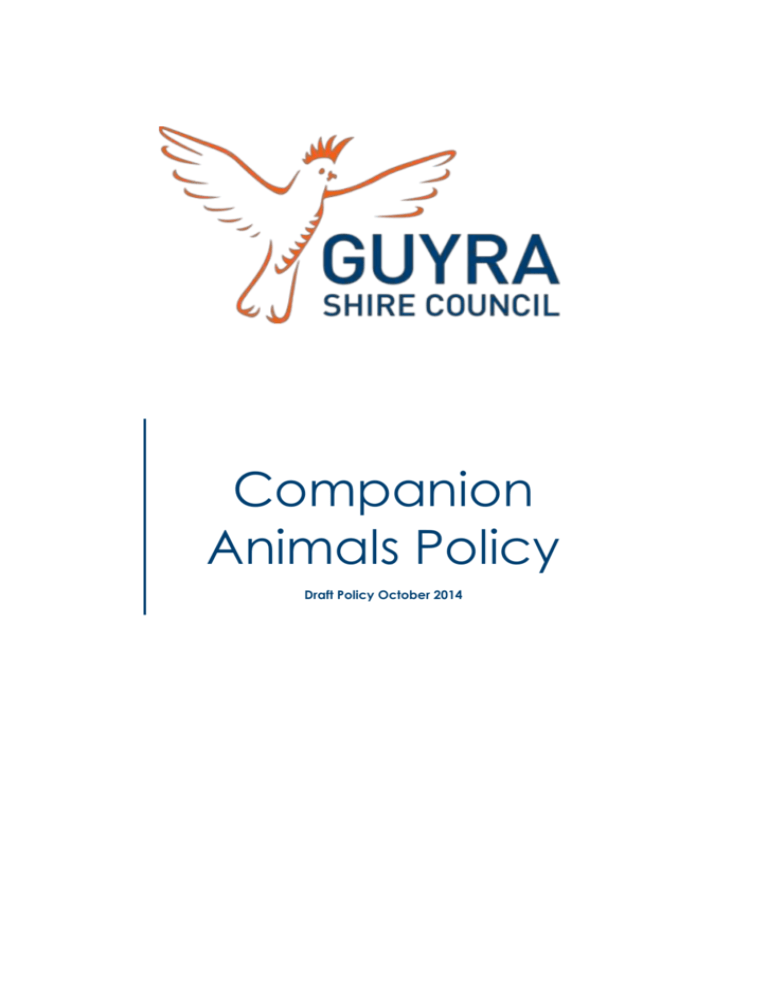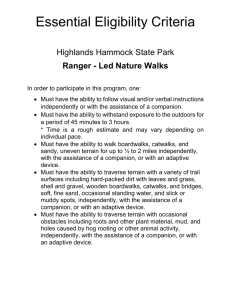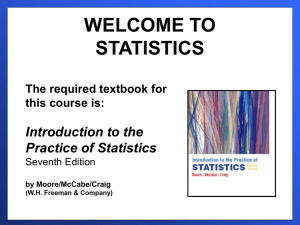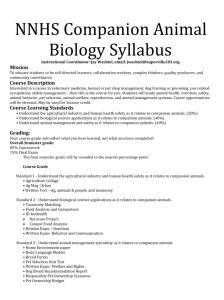Draft Companion Animals Policy
advertisement

Companion Animals Policy Draft Policy October 2014 COMPANION ANIMALS POLICY Applies to: Rangers Officer Responsible Manager – Planning, Regulatory & Community Services Associated Documents All Related Standard Practice Notes Legislation Animal Trades Regulation 1996 of the Prevention of Cruelty to Animals Act 1979, The NSW Companion Animals Act 1998 History New Policy Page | 2 COMPANION ANIMALS POLICY CONTENTS OBJECTIVES: ............................................................................................................................................................ 4 RESPONSIBILITIES OF PET OWNERS: ....................................................................................................................... 4 COMPANION ANIMALS LEGISLATION: .................................................................................................................... 4 Lifetime Registration Fees .................................................................................................................................. 4 PET FACILITIES: ........................................................................................................................................................ 5 ENFORCEMENT: ...................................................................................................................................................... 5 Straying ............................................................................................................................................................... 5 Barking ................................................................................................................................................................ 5 Dog Attacks ......................................................................................................................................................... 6 TREATMENT OF FERAL AND INFANT ANIMALS AT POUNDS AND SHELTERS: .......................................................... 6 KEEPING OF ANIMALS IN URBAN AREAS: ................................................................................................................ 6 Bees .................................................................................................................................................................... 6 Birds .................................................................................................................................................................... 6 Cats ..................................................................................................................................................................... 7 Dogs .................................................................................................................................................................... 7 Goats and Sheep ................................................................................................................................................. 8 Horses and Cattle................................................................................................................................................ 8 Pigs...................................................................................................................................................................... 8 Poultry ................................................................................................................................................................ 9 USEFUL CONTACTS: .............................................................................................................................................. 10 Page | 3 COMPANION ANIMALS POLICY OBJECTIVES: 1. 2. 3. 4. Encourage responsible pet ownership and minimise nuisance effects of pets. Provide for identification and registration of companion animals. Identify areas where companion animals may need to be restricted. Outline companion animal control, handling and enforcement approaches. RESPONSIBILITIES OF PET OWNERS: To select the right companion animal for your lifestyle. To contain your companion animal within your property. To keep your dog on a leash when in public. Promptly disposing of faeces deposited in public areas. Ensure your dog or cat is readily identifiable (collar and identification tags). COMPANION ANIMALS LEGISLATION: The existing legislation requires: All dogs and cats to be micro chipped and lifetime registered on the Companion Animals Register. Dogs must wear a collar and tag detailing contact information. (Cats are not legally required to wear contact details, although it is strongly encouraged). Owners must advise the Companion Animals Register through Council of any changes of ownership, or change of contact details. LIFETIME REGISTRATION FEES From 1 July 2014 cat and dog lifetime registration fees are as follows: Desexed animal $51.00 Non-desexed animal $188.00 Breeder concession $51.00 Pensioner concession $20.00 Working Dog $0.00 These fees are subject to change, for current fees please see the Office of Local Government website at http://www.olg.nsw.gov.au/content/registration-fees. Page | 4 COMPANION ANIMALS POLICY PET FACILITIES: Off Leash Area Leggo Park, Corner of McKenzie and Boorolong Streets, Guyra Animal Shelter/Pound Works Depot Ryanda Street, Guyra Tingha Depot New Valley Road, Tingha ENFORCEMENT: The Companion Animals Act provides for the enforcement of control for companion animals and the application of penalties where the relevant controls have not be complied with. The focus of enforcement procedures is primarily on controlling nuisance situations, particularly barking, biting and straying. STRAYING When our rangers first locate a straying animal they attempt to identify the animal via tags or a microchip and return to the owner without penalty or fine. However for repeat offenders, the animal will be returned with the appropriate fine. When the owner cannot be contacted or identified, the animal will be taken to Councils Animal Shelter/Pound and will be detained until the owner seeks its release. The release of the animal may also be subject to a fine and/or the reimbursement of maintenance costs for the period that their animal has been detained. Identifiable animals will be detained for a maximum period of fourteen (14) days, while unidentifiable animals will only be detained for a maximum period of seven (7) days. After this time Council staff will endeavour to rehouse the animal. Failure to rehouse the animal will result in its destruction, in accordance with the conditions of the Companion Animals Act. BARKING When a complaint is made, Council staff will visit the site and verify the extent of the issue which may include a discussion with the neighbours. The dog owner will be given a warning and suggestions will be provided by Council staff as to how the issue may be resolved. Repeated visits will results in a Nuisance Dog Order being issued. Page | 5 COMPANION ANIMALS POLICY DOG ATTACKS In the case of a dog attack, Council staff will seize the dog if necessary and prosecute the owners. If the owner is able to secure the dog effectively, the dog may be allowed to remain restrained on the owners property. Prosecutions may be taken before a Magistrate in order to obtain authority for the destruction of the dog if this is deemed necessary. TREATMENT OF FERAL AND INFANT ANIMALS AT POUNDS AND SHELTERS: Feral animals often exhibit signs of extreme distress when confined at an animal shelter or pound, and are often anti social. As such, they are often unsuitable for rehoming and are usually euthanised at the earliest possible time. Infant companion animals require high levels of care by staff and usually need to be held for substantial periods of time, until they are independent enough to be rehomed. Therefore, Council staff may seek assistance from welfare groups equipped to provide specialised care to these animals and arrange for them to be placed in new homes. In cases where the infant animals are ill or suitable carers cannot be found, the animals will be euthanised at the earliest possible time. KEEPING OF ANIMALS IN URBAN AREAS: Urban Areas – land that is zoned R1 Residential, B2 Local Centre, RU5 Village and IN1 General Industrial, under the Guyra Local Environmental Plan 2012. BEES One standard 10 frame beehive may be kept without the special permission of Council. Beehives must be registered with the NSW Department of Primary Industries. BIRDS Commercial aviaries require development consent; however the construction of small private bird aviaries may be exempt from approval, pursuant to Council’s Local Environmental Plan. Noise emissions must be maintained at or below 5dB above background noise level at the property boundary. Cockatoo-type breeds will be the subject of strict controls relating to objectionable noise and/or unreasonable hours. Food storage areas and the ground surface beneath are to be cleansed as frequently as is necessary to preserve a state of cleanliness, free from offensive odour and in such a manner as to ensure that flies and/or vermin are not attracted to the premises. Page | 6 COMPANION ANIMALS POLICY CATS The keeping of cats is encouraged under the following conditions: (i) Cats do not cause damage to other property. (ii) Cats do not cause a nuisance to other residents. The behaviour of the cats is subject to the provisions of the Companion Animals Act 1998 and owners are encouraged to contain their cats during the hours of darkness to prevent attacks on native fauna. A maximum of 6 cats normally housed at any premises on an urban allotment, is the basis for Council’s administration of the Orders provisions for numbers under the Local Government Act. DOGS The behaviour of dogs is subject to the provisions of the Companion Animals Act 1998. Dogs kept at urban properties are to have adequate shelter and protection from the weather. The area in which the dogs are housed is to be maintained in a hygienic condition to: (i) Limit the spread of disease; and. (ii) Minimise offensive odour. The following maximum numbers of dogs housed at a premises on any urban allotment will form the basis for Council’s administration of the Orders provisions for numbers under the Local Government Act: Up to 1000m2 2 Dogs Up to 2000m2 3 Dogs 2000m2 and above 4 Dogs Construction of kennel facilities must comply with the Building Code of Australia. Disposal of faeces and other animal related waste must be to an approved sewer connection or other adequate approved means of disposal. Page | 7 COMPANION ANIMALS POLICY GOATS AND SHEEP The keeping of sheep or goats for commercial purposes within a residential area is not permitted. The use of sheep and goats to maintain an area in a neat and tidy condition is encouraged provided that: (i) The area is fenced satisfactorily to prevent their escape. (ii) Neighbouring trees/shrubs are protected. (iii) The area is kept free of offensive odour and flies. One animal per 750m2 per allotment is to be used as a basis for administering the Orders provisions for numbers under the Local Government Act. HORSES AND CATTLE Note: The Regulation to the Act (see specifically Schedule 2 of the Local Government (General) Regulation 2005) includes standards for the keeping of horses and cattle. These provisions must be read in connection with this Policy. The keeping of horses and cattle for commercial purposes or feed lots within a residential area is not permitted. The use of horses or cattle to maintain a vacant urban area in a neat and tidy condition is encouraged, subject to the following conditions: (i) That the area is fenced satisfactorily to prevent their escape. (ii) Horses and cattle must not be kept within 9 metres of a dwelling and other buildings usually occupied by humans and not less than 1 metre from any boundary fences, to prevent damage to such fences. (iii) Neighbouring trees/shrubs are to be protected. (iv) The area must be kept free of offensive odour/flies and rodents. One animal per 1000m2 allotment is to be used as a basis for administering the Orders provisions for numbers under the Local Government Act. PIGS Note: The Regulation to the Act (see specifically Schedule 2 of the Local Government (General) Regulation 2005) includes standards for the keeping of swine. These provisions must be read in connection with this Policy. One animal per 2000m2 allotment is to be used as a basis for administering the Orders provisions for numbers under the Local Government Act. Page | 8 COMPANION ANIMALS POLICY POULTRY Note: The Regulation to the Act (see specifically Schedule 2 of the Local Government (General) Regulation 2005) includes standards for the keeping of poultry. These provisions must be read in connection with this Policy. The keeping of poultry in a residential area is encouraged, subject to the following conditions: (i) The area is kept free of offensive odour/flies and rodents. (ii) The poultry yard is fenced to ensure the poultry do not escape. (iii) Cages/Hen houses must have a concrete floor and comply with the Building Code of Australia. (iv) The following distances for the location of poultry housing from a dwelling are considered adequate: (v) Housing for Fowls (gallus gallus) or guinea fowls 4.5 Metres Other Housing (e.g. Ducks/Geese) 30 Metres Roosters are not permitted unless they are able to be housed within a properly constructed sound reduction shed. The following maximum numbers to be housed at a premises on any urban allotment will be used as a basis for administering the Orders provisions for numbers under the Local Government Act. Hens 20 fowls Other poultry 10 birds Page | 9 COMPANION ANIMALS POLICY USEFUL CONTACTS: RSPCA Armidale – 0412 217 364 www.rspcansw.org.au NORTHERN TABLELANDS WILDLIFE CARERS (02) 6775 3767 (02) 6771 3352 (02) 6775 3747 NSW CAT FANCIERS’ ASSOCIATION (02) 9834 6577 www.nswcfa.asn.au DOGS NSW (02) 9834 3022 1300 728 022 www.dogsnsw.org.au NEW ENGLAND REGIONAL COMPANION ANIMALS SHELTER (02) 6771 5498 NATIONAL PARKS AND WILDLIFE SERVICE (02) 6738 9100 WIRES (02) 6778 4994 Page | 10




